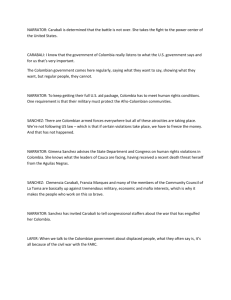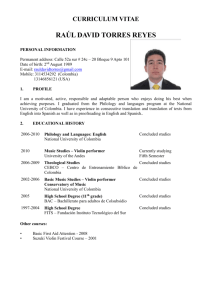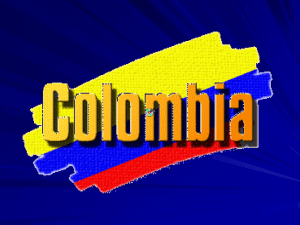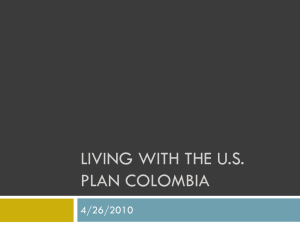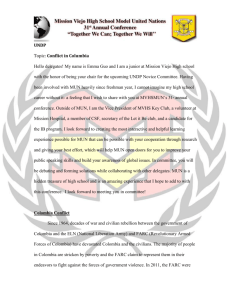After winning re
advertisement
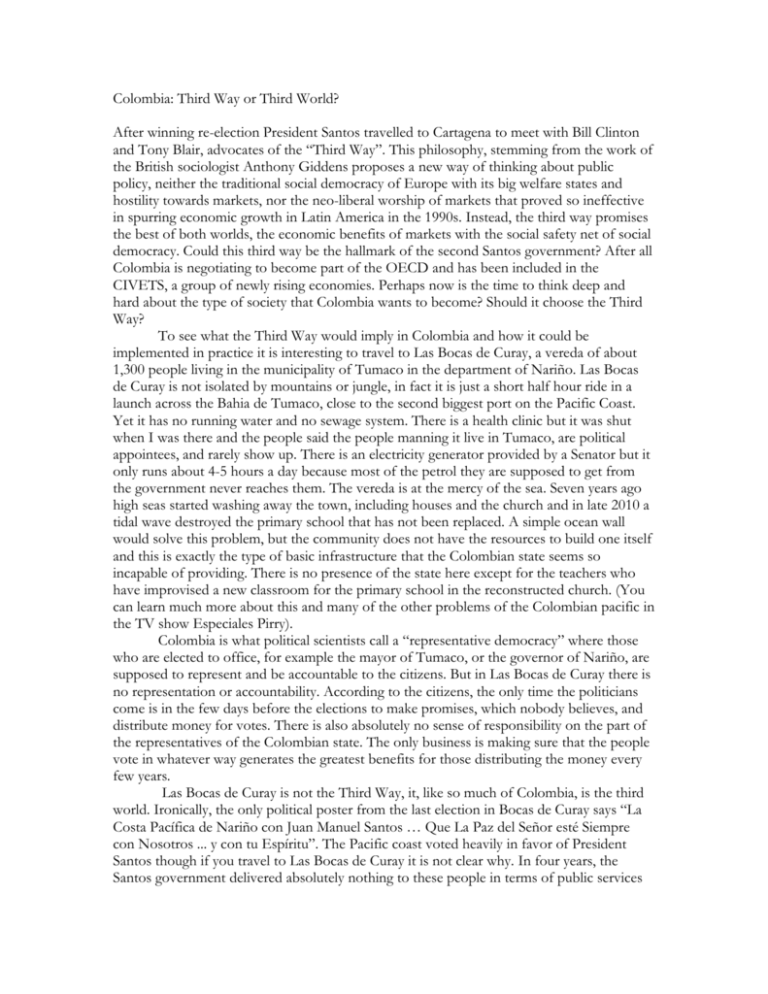
Colombia: Third Way or Third World? After winning re-election President Santos travelled to Cartagena to meet with Bill Clinton and Tony Blair, advocates of the “Third Way”. This philosophy, stemming from the work of the British sociologist Anthony Giddens proposes a new way of thinking about public policy, neither the traditional social democracy of Europe with its big welfare states and hostility towards markets, nor the neo-liberal worship of markets that proved so ineffective in spurring economic growth in Latin America in the 1990s. Instead, the third way promises the best of both worlds, the economic benefits of markets with the social safety net of social democracy. Could this third way be the hallmark of the second Santos government? After all Colombia is negotiating to become part of the OECD and has been included in the CIVETS, a group of newly rising economies. Perhaps now is the time to think deep and hard about the type of society that Colombia wants to become? Should it choose the Third Way? To see what the Third Way would imply in Colombia and how it could be implemented in practice it is interesting to travel to Las Bocas de Curay, a vereda of about 1,300 people living in the municipality of Tumaco in the department of Nariño. Las Bocas de Curay is not isolated by mountains or jungle, in fact it is just a short half hour ride in a launch across the Bahia de Tumaco, close to the second biggest port on the Pacific Coast. Yet it has no running water and no sewage system. There is a health clinic but it was shut when I was there and the people said the people manning it live in Tumaco, are political appointees, and rarely show up. There is an electricity generator provided by a Senator but it only runs about 4-5 hours a day because most of the petrol they are supposed to get from the government never reaches them. The vereda is at the mercy of the sea. Seven years ago high seas started washing away the town, including houses and the church and in late 2010 a tidal wave destroyed the primary school that has not been replaced. A simple ocean wall would solve this problem, but the community does not have the resources to build one itself and this is exactly the type of basic infrastructure that the Colombian state seems so incapable of providing. There is no presence of the state here except for the teachers who have improvised a new classroom for the primary school in the reconstructed church. (You can learn much more about this and many of the other problems of the Colombian pacific in the TV show Especiales Pirry). Colombia is what political scientists call a “representative democracy” where those who are elected to office, for example the mayor of Tumaco, or the governor of Nariño, are supposed to represent and be accountable to the citizens. But in Las Bocas de Curay there is no representation or accountability. According to the citizens, the only time the politicians come is in the few days before the elections to make promises, which nobody believes, and distribute money for votes. There is also absolutely no sense of responsibility on the part of the representatives of the Colombian state. The only business is making sure that the people vote in whatever way generates the greatest benefits for those distributing the money every few years. Las Bocas de Curay is not the Third Way, it, like so much of Colombia, is the third world. Ironically, the only political poster from the last election in Bocas de Curay says “La Costa Pacífica de Nariño con Juan Manuel Santos … Que La Paz del Señor esté Siempre con Nosotros ... y con tu Espíritu”. The Pacific coast voted heavily in favor of President Santos though if you travel to Las Bocas de Curay it is not clear why. In four years, the Santos government delivered absolutely nothing to these people in terms of public services not even managing to replace the school destroyed by the sea. At the same time “la Paz del Señor” left the inhabitants endlessly exposed to harassment by armed groups. Unfortunately, Las Bocas de Curay is representative of hundreds, thousands of veredas in Colombia. Set adrift by the Colombian state they have to fare for themselves without resources or any potential of getting the political system to take account of their interests and without the basic public goods or services that would help them to change their destiny. Las Bocas de Curay shows the emptiness of the notion that Colombia could adopt the Third Way. Giddens defines this as “a framework for thinking and policymaking that seeks to adapt social democracy to a world which has changed fundamentally over the past two or three decades. It is a third way in the sense that it is an attempt to transcend both oldstyle social democracy and neoliberalism”. But where is either social democracy or neoliberalism in Las Bocas de Curay or Colombia more generally? To be a social democracy, Colombia would have to have a state that could provide basic services and rights to all of its citizens. But it singularly fails to do so. Neither has Colombia ever been neoliberal in the sense of allowing free markets to dominate the economy. Instead, it is a sea of monopolies and cartels where political connections and barriers to entry are the way to make big fortunes, as the list of the richest Colombians well illustrates. In fact the “Third Way” is a set of policy options for a democratic country with a modern state. Colombia is neither. Its democracy is of remarkably low quality, riven by fraud, violence, clientelism and vote buying that sever the link of accountability between citizen and “representative”. Its state does not command a monopoly of violence, is unable to raise resources (tax revenues as a % of GDP are about the same as Egypt, Ghana or Benin in Africa) and lacks a modern bureaucratized administration outside a few pockets of excellence. For example, the OECD evaluation of Colombian institutions points out that Colombia has the smallest bureaucracy relative to population of any country in Latin America and that half of the people employed are “provisional staff” outside of the proper career path for civil servants – in effect political appointees. There is no “Third Way” for Colombia, only the third world. Even if the Third Way is an irrelevant chimera for Colombia, it would be good if President Santos read Giddens’ famous book because it emphasizes some things that the country desperately needs, like a fight against the social exclusion that characterises the society, “exclusion is … about mechanisms that act to detach groups of people from the social mainstream. At the top, voluntary exclusion is driven by a diversity of factors. Having the economic means to pull out of the wider society is the necessary condition for, but never the whole explanation as to why, groups choose to do so. Exclusion at the top is not only just as threatening for public space, or common solidarity, as exclusion at the bottom; it is causally linked to it … Limiting the voluntary exclusion of the elites is central to creating a more inclusive society at the bottom.” There can be no better statement of Colombia’s problems than its exclusion at the top and the bottom. At elite withdrawn from the real society, which is unwilling to pay taxes to support any socially beneficial project. The OECD report that while the poorest 10% of the population pay 4.5% of their income in taxes, the richest 10% pays 2.8%. That will be an OECD record. At the same time, this elite imagines itself running a country about to become modern, playing with ideas like the Third Way. No wonder magical realism was invented in Colombia. Giddens himself even inadvertently illustrates just how out of touch the Colombian elite are with the reality of their country when he reproduces in his book the story of “a Colombian delegate to a meeting of the Socialist International in 1989” who remarked that “My party is called liberal, but it is basically quite socialist. With the Europeans it’s the other way round.” Whatever socialism means in Colombia it clearly does not involve providing basic public goods and services to its citizens or caring about their welfare and opportunities. “La Paz del Señor” that President Santos has promoted is a great thing for Colombia. But it is the start, not the end of making Colombia a new country. To figure out what that involves, I’d suggest he start in Las Bocas de Curay.


